
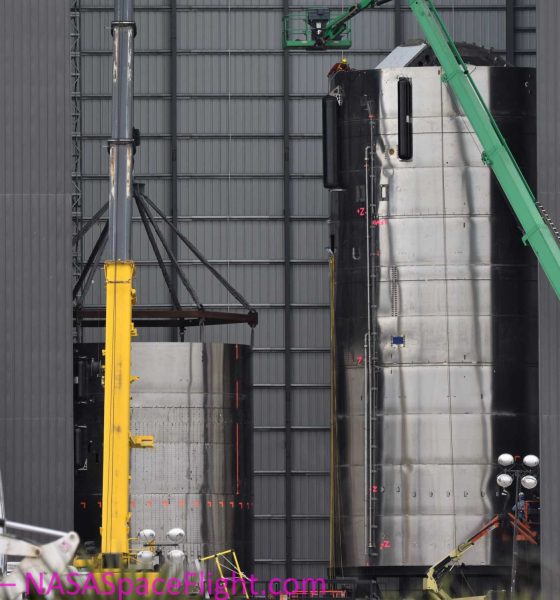
News
SpaceX’s recent Starship testing challenges don’t worry Elon Musk
In his latest burst of tweets, SpaceX CEO Elon Musk says he isn’t all that worried about a duo of recent Starship prototype failures and talked next steps for the next few Starships.
Aside from SpaceX’s South Texas rocket factory, Musk also touched on progress being made on the cutting-edge Raptor engine set to power Starships and their boosters, revealing a small production milestone in the process. The CEO says that SpaceX has already begun building its 26th Raptor engine, a sign that Raptors may actually be waiting on Starships in a turn of events. Back when SpaceX was busy testing its low-fidelity Starhopper testbed, the ship actually had to wait several months for the full-scale Raptor engine’s design to mature enough to support 15-30+ second hop tests.
Now, Musk’s Raptor SN26 reveal implies that SpaceX is slowly but surely ramping up production of the new engine back at its Hawthorne, California headquarters.
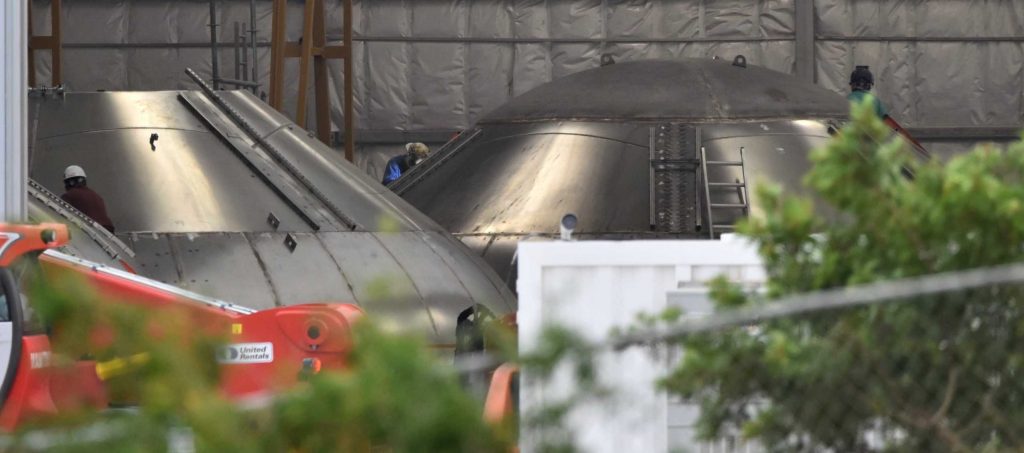
From August to December 2019, SpaceX completed one Raptor engine every ~17 days, on average. With Musk’s confirmation that SpaceX is currently building (or already testing) SN26, the company is completing an engine every 12-14 days – an overall improvement of 20-40%. In other words, SpaceX’s growing engine production capacity is almost perfectly positioned to support a fleet of suborbital Starship prototypes, which is about where the company’s Boca Chica, Texas factory is today.
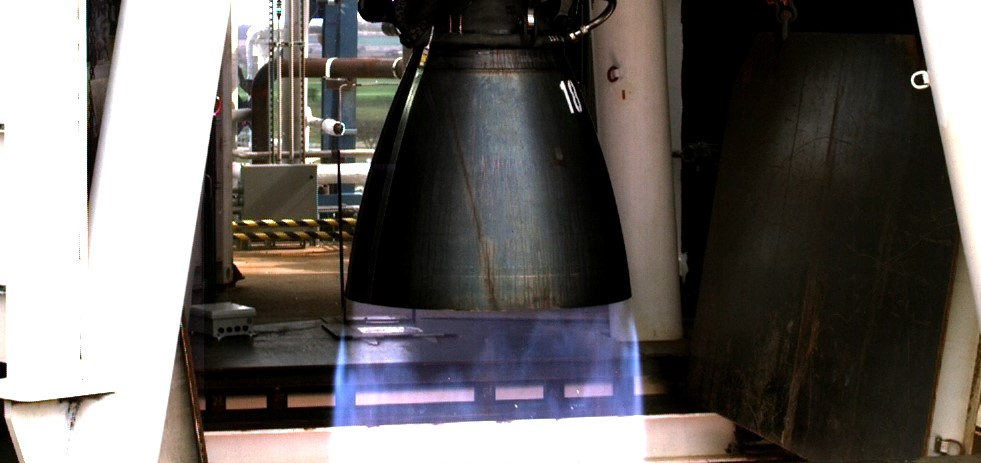
Obviously, following two recent full-scale Starship prototype failures spaced barely a month apart, rocket production has a ways to go before it will need the volume of Raptor engines SpaceX appears to already be capable of producing. For the time being, three Raptor engines – having already completed production in Hawthorne and acceptance testing in McGregor, Texas – are quite literally sitting around and gathering dust as they wait for the first Starship prototype qualified to host them.
Once a Starship passes proof testing, SpaceX will be able to install either one or all three engines for an inaugural static fire test, following by a small Starhopper-class hop (no higher than 150m or 500 ft).
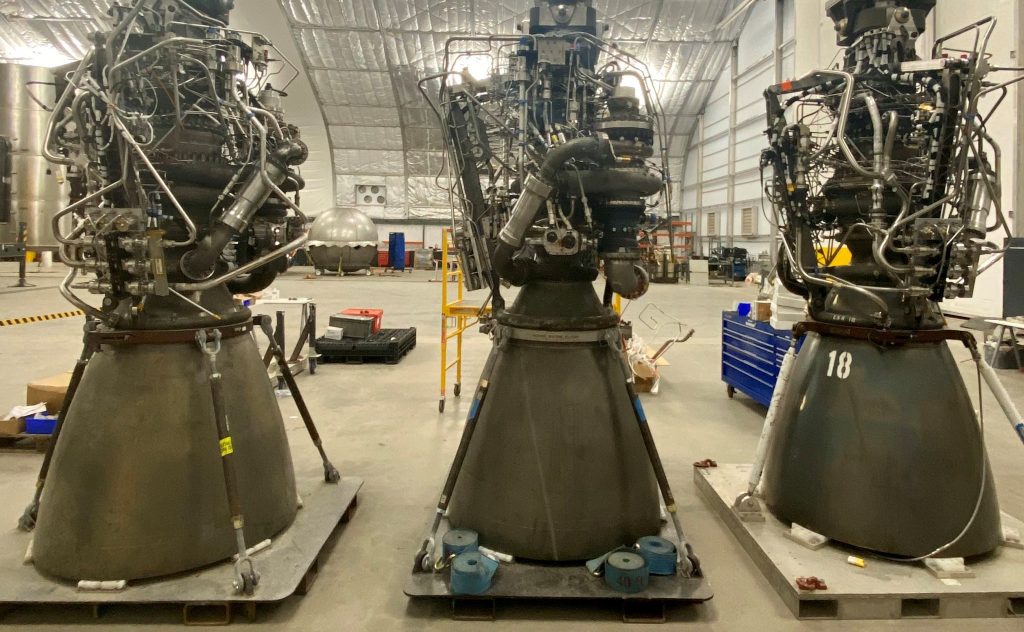
However, once SpaceX has explored the full range of testing available to suborbital Starship prototypes, things will change. Likely ending with the first one or several successful ‘skydiver-style’ rocket landing tests, SpaceX will finally be able to seriously think about its first orbital flight tests. To reach orbit and still be capable of returning to Earth and landing softly, Starship will need a Super Heavy booster – set to be the largest rocket booster ever developed by a large margin.
Although Musk has stated that early orbital flight tests will likely launch with far fewer engines, a single Super Heavy booster could eventually require 37 Raptor engines – a full 42% more engines than SpaceX has managed to build in the entire 15+ month history of full-scale Raptor production.
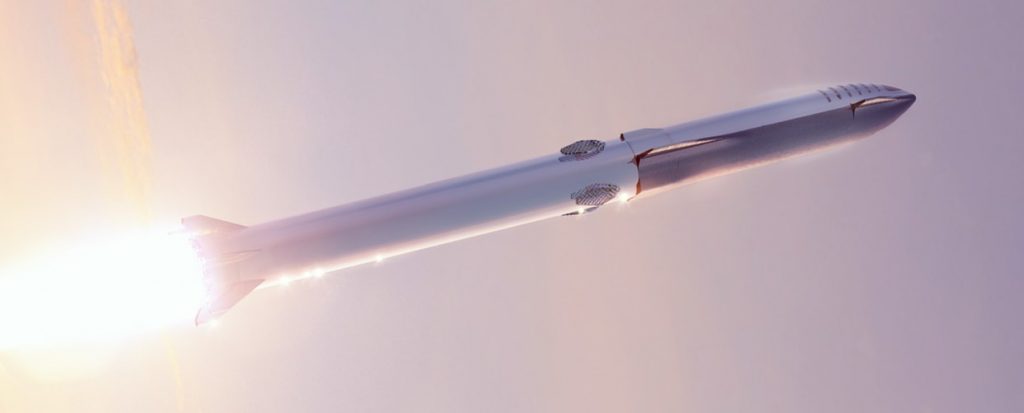
Thankfully, SpaceX’s engine production HQ likely has at least 6-12 months to ramp up production to support fully-outfitted Super Heavy boosters – let alone several. For the time being, each suborbital Starship only needs 3 sea level-optimized Raptor engines, although it’s possible that SpaceX will eventually perform suborbital tests with a full compliment of six engines – including three with much larger vacuum-optimized nozzles.
Ultimately, Musk explained that his lack of concern about recent Starship prototype failures – potentially including any anomalies that follow SN4’s test campaign – comes from the fact that he believes that producing Starships is a much more challenging and pressing concern. Indeed, if your factory can churn out functioning building-sized spacecraft for pennies on the dollar, losing a few during testing is little more than an annoyance. The first failed prototypes can thus be considered learning experiences, helping SpaceX improve designs and optimize the factory and production strategies. SpaceX does still need to prove that its existing approach really can build functioning rockets, but that should (in theory) come with enough trial and error.
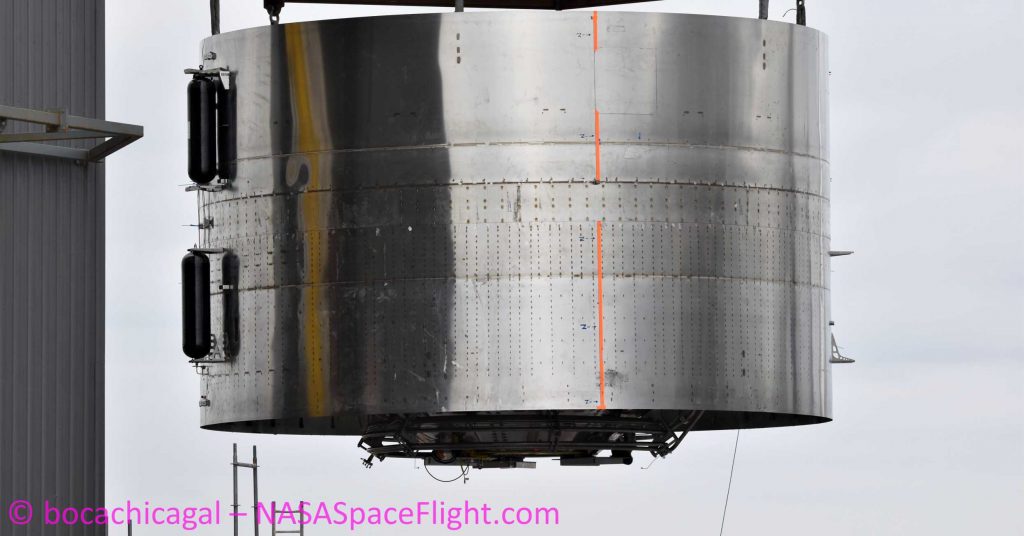
Depending on how initial tests go with Starship Serial Number 4 (SN4), likely days away from wrapping up production, Musk says that the first few suborbital Starship tests will likely involve short, low-velocity hops. Those flights will be slow enough that the ship (or ships) wont require aerodynamic control surfaces to complete them, instead relying entirely on smaller thrusters and the thrust vector control (TVC) provided by their three main Raptor engines.
If Starship SN4 testing – including wet dress rehearsals, Raptor static fires, and short hops – goes perfectly, Musk says that Starship SN5 could be the first new ship to have fully-functional flaps installed. If things don’t go quite as well, that milestone could shift to Starship SN6, while SN7 and beyond are obviously on the table in the event of even less forgiving SN4/SN5 testing scenarios. For now, Starship SN4 could be ready to move to the launch pad and kick off a series of critical proof tests a handful of days from now.

News
Tesla FSD v14.2.2 is getting rave reviews from drivers
So far, early testers have reported buttery-smooth drives with confident performance, even at night or on twisty roads.

Tesla Full Self-Driving (Supervised) v14.2.2 is receiving positive reviews from owners, with several drivers praising the build’s lack of hesitation during lane changes and its smoother decision-making, among others.
The update, which started rolling out on Monday, also adds features like dynamic arrival pin adjustment. So far, early testers have reported buttery-smooth drives with confident performance, even at night or on twisty roads.
Owners highlight major improvements
Longtime Tesla owner and FSD user @BLKMDL3 shared a detailed 10-hour impression of FSD v14.2.2, noting that the system exhibited “zero lane change hesitation” and “extremely refined” lane choices. He praised Mad Max mode’s performance, stellar parking in locations including ticket dispensers, and impressive canyon runs even in dark conditions.
Fellow FSD user Dan Burkland reported an hour of FSD v14.2.2’s nighttime driving with “zero hesitations” and “buttery smooth” confidence reminiscent of Robotaxi rides in areas such as Austin, Texas. Veteran FSD user Whole Mars Catalog also demonstrated voice navigation via Grok, while Tesla owner Devin Olsen completed a nearly two-hour drive with FSD v14.2.2 in heavy traffic and rain with strong performance.
Closer to unsupervised
FSD has been receiving rave reviews, even from Tesla’s competitors. Xpeng CEO He Xiaopeng, for one, offered fresh praise for FSD v14.2 after visiting Silicon Valley. Following extended test drives of Tesla vehicles running the latest FSD software, He stated that the system has made major strides, reinforcing his view that Tesla’s approach to autonomy is indeed the proper path towards autonomy.
According to He, Tesla’s FSD has evolved from a smooth Level 2 advanced driver assistance system into what he described as a “near-Level 4” experience in terms of capabilities. While acknowledging that areas of improvement are still present, the Xpeng CEO stated that FSD’s current iteration significantly surpasses last year’s capabilities. He also reiterated his belief that Tesla’s strategy of using the same autonomous software and hardware architecture across private vehicles and robotaxis is the right long-term approach, as it would allow users to bypass intermediate autonomy stages and move closer to Level 4 functionality.
News
Elon Musk’s Grok AI to be used in U.S. War Department’s bespoke AI platform
The partnership aims to provide advanced capabilities to 3 million military and civilian personnel.

The U.S. Department of War announced Monday an agreement with Elon Musk’s xAI to embed the company’s frontier artificial intelligence systems, powered by the Grok family of models, into the department’s bespoke AI platform GenAI.mil.
The partnership aims to provide advanced capabilities to 3 million military and civilian personnel, with initial deployment targeted for early 2026 at Impact Level 5 (IL5) for secure handling of Controlled Unclassified Information.
xAI Integration
As noted by the War Department’s press release, GenAI.mil, its bespoke AI platform, will gain xAI for the Government’s suite of tools, which enable real-time global insights from the X platform for “decisive information advantage.” The rollout builds on xAI’s July launch of products for U.S. government customers, including federal, state, local, and national security use cases.
“Targeted for initial deployment in early 2026, this integration will allow all military and civilian personnel to use xAI’s capabilities at Impact Level 5 (IL5), enabling the secure handling of Controlled Unclassified Information (CUI) in daily workflows. Users will also gain access to real‑time global insights from the X platform, providing War Department personnel with a decisive information advantage,” the Department of War wrote in a press release.
Strategic advantages
The deal marks another step in the Department of War’s efforts to use cutting-edge AI in its operations. xAI, for its part, highlighted that its tools can support administrative tasks at the federal, state and local levels, as well as “critical mission use cases” at the front line of military operations.
“The War Department will continue scaling an AI ecosystem built for speed, security, and decision superiority. Newly IL5-certified capabilities will empower every aspect of the Department’s workforce, turning AI into a daily operational asset. This announcement marks another milestone in America’s AI revolution, and the War Department is driving that momentum forward,” the War Department noted.
News
Tesla FSD (Supervised) v14.2.2 starts rolling out
The update focuses on smoother real-world performance, better obstacle awareness, and precise end-of-trip routing, among other improvements.

Tesla has started rolling out Full Self-Driving (Supervised) v14.2.2, bringing further refinements to its most advanced driver-assist system. The new FSD update focuses on smoother real-world performance, better obstacle awareness, and precise end-of-trip routing, among other improvements.
Key FSD v14.2.2 improvements
As noted by Not a Tesla App, FSD v14.2.2 upgrades the vision encoder neural network with higher resolution features, enhancing detection of emergency vehicles, road obstacles, and human gestures. New Arrival Options let users select preferred drop-off styles, such as Parking Lot, Street, Driveway, Parking Garage, or Curbside, with the navigation pin automatically adjusting to the user’s ideal spot for precision.
Other additions include pulling over for emergency vehicles, real-time vision-based detours for blocked roads, improved gate and debris handling, and extreme Speed Profiles for customized driving styles. Reliability gains cover fault recovery, residue alerts on the windshield, and automatic narrow-field camera washing for new 2026 Model Y units.
FSD v14.2.2 also boosts unprotected turns, lane changes, cut-ins, and school bus scenarios, among other things. Tesla also noted that users’ FSD statistics will be saved under Controls > Autopilot, which should help drivers easily view how much they are using FSD in their daily drives.
Key FSD v14.2.2 release notes
Full Self-Driving (Supervised) v14.2.2 includes:
- Upgraded the neural network vision encoder, leveraging higher resolution features to further improve scenarios like handling emergency vehicles, obstacles on the road, and human gestures.
- Added Arrival Options for you to select where FSD should park: in a Parking Lot, on the Street, in a Driveway, in a Parking Garage, or at the Curbside.
- Added handling to pull over or yield for emergency vehicles (e.g. police cars, fire trucks, ambulances).
- Added navigation and routing into the vision-based neural network for real-time handling of blocked roads and detours.
- Added additional Speed Profile to further customize driving style preference.
- Improved handling for static and dynamic gates.
- Improved offsetting for road debris (e.g. tires, tree branches, boxes).
- Improve handling of several scenarios, including unprotected turns, lane changes, vehicle cut-ins, and school buses.
- Improved FSD’s ability to manage system faults and recover smoothly from degraded operation for enhanced reliability.
- Added alerting for residue build-up on interior windshield that may impact front camera visibility. If affected, visit Service for cleaning!
- Added automatic narrow field washing to provide rapid and efficient front camera self-cleaning, and optimize aerodynamics wash at higher vehicle speed.
- Camera visibility can lead to increased attention monitoring sensitivity.
Upcoming Improvements:
- Overall smoothness and sentience.
- Parking spot selection and parking quality.








